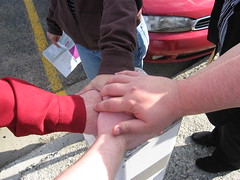Speaker: Marshall Breeding
Check & update your library’s record on lib-web-cats — Breeding uses this data to track the ILS and ERMS systems used by libraries world-wide.
The automation industry is consolidating, with several library products dropped or ceased to be supported. External financial investors are increasingly controlling the direction of the industry. And, the OPAC sucks. Libraries and users are continually frustrated with the products they are forced to use and are turning to open source solutions.
The innovation presented by automation companies falls below the expectations of libraries (not so sure about users). Conventional ILS need to be updated to incorporate the modern blend of digital and print collections.
We need to be more thoughtful in our incorporation of social tools into traditional library systems and infrastructures. Integrate those Web 2.0 tools into existing delivery options. The next NextGen automation tools should have collaborative features built into them.
Open source software isn’t free — it’s just a different model (pay for maintenance and setup v. pay for software). We need more robust open source software for libraries. Alternatively, systems need to open up so that data can be moved in and out easily. Systems need APIs that allow local coders to enhance systems to meet the needs of local users. Open source ERMS knowledge bases haven’t been seriously developed, although there is a need.
The drive towards open source solutions has often been motivated by disillusionment with current vendors. However, we need to be cautious, since open source isn’t necessarily the golden key that will unlock the door to paradise. (i.e. Koha still needs to add serials and acquisitions modules, as well as EDI capabilities).
The open source movement motivates the vendors to make their systems more open for us. This is a good thing. In the end, we’ll have a better set of options.
Open Source ILS options: Koha (commercial support from LibLime) used mostly by small to medium libraries, Evergreen (commercial support from Equinox Software) tested and proven for small to medium libraries in a consortia setting, and OPALS (commercial support from Media Flex) used mostly by k-12 schools.
In making the case for open source ILS, you need to compare the total cost of ownership, the features and functionality, and the technology platform and conceptual models. Are they next-generation systems or open source versions of legacy models?
Evaluate your RFPs for new systems. Are you asking for the things you really need or are you stuck in a rut of requiring technology that was developed in the 70s and may no longer be relevant?
Current open source ILS products lack serials and acquisitions modules. The initial wave of open source ILS commitments happened in the public library arena, but the recent activity has been in academic libraries (WALDO consortia going from Voyager to Koha, University of Prince Edward Island going from Unicorn to Evergreen in about a month). Do the current open source ILS products provide a new model of automation, or an open source version of what we already have?
Looking forward to the day when there is a standard XML for all ILS that will allow libraries to manipulated their data in any way they need to.
We are working towards a new model of library automation where monolithic legacy architectures are replaced by the fabric of service oriented architecture applications with comprehensive management.
The traditional ILS is diminishing in importance in libraries. Electronic content management is being done outside of core ILS functions. Library systems are becoming less integrated because the traditional ILS isn’t keeping up with our needs, so we find work-around products. Non-integrated automation is not sustainable.
ERMS — isn’t this what the acquisitions module is supposed to do? Instead of enhancing that to incorporate the needs of electronic resources, we had to get another module or work-around that may or may not be integrated with the rest of the ILS.
We are moving beyond metadata searching to searching the actual items themselves. Users want to be able to search across all products and packages. NextGen federated searching will harvest and index subscribed content so that it can be searched and retrieved more quickly and seamlessly.
Opportunities for serials specialists:
- Be aware of the current trends
- Be prepared for accelerated change cycles
- Help build systems based on modern business process automation principles. What is your ideal serials system?
- Provide input
- Ensure that new systems provide better support than legacy systems
- Help drive current vendors towards open systems
How will we deliver serials content through discovery layers?
Reference:
- “It’s Time to Break the Mold of the Original ILS,” Computers in Libraries, Nov/Dec 2007.


